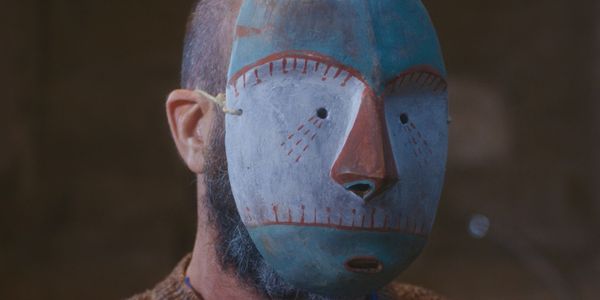Toronto International Film Festival 2018: ULYSSES & MONA: The Art Life Made Disappointing

Tomas is a chronic cineaste who studied English literature in…
Ulysses & Mona opens with a shot of a tennis machine spewing out balls for an unseen tennis aficionado, while a twee synth-based score by Minizza bounces its own rhythm in your ears. It feels like an apt summation of Sébastien Betbeder’s film: the score foreshadows its largely precocious tone, while the machine is representative of Betbeder himself, lobbing out his ideas to us and hoping we serve back appreciatively.
The trouble is, the machine is set on the easiest mode possible, so we serve back diligently but unenthusiastically. If the reward is in the challenge, then there’s no help in being disappointed.
A Tale of Two Artists
I feel like going into the plot too much will end up summarizing the entirety of the film, so I’ll keep it brief. On one end we have Ulysses (Eric Cantona), a former conceptual artist whose life has become one of perpetual apathy and boredom. His house is in need of repair, he’s estranged from his family, and his only friend seems to be the local youngster, Arthur (Mathis Romani), who totes a paintball gun and speaks imaginatively of extraterrestrials. His last remaining joys seem to be his beloved Labrador Retriever, Joseph, and one-sided tennis matches.

On the other end is Mona (Manal Issa), an art student bored with workaday theories who decides that she wants to meet her role model, Ulysses. She is hopeful that she can revive his career and become his assistant, but their first meeting ends in refusal. When she tries again, she finds him unconscious on his tennis court, bleeding from a head wound. It turns out that he fainted—the fainting spell caused by a cancerous tumor. Keeping this life-changing news from Mona, Ulysses finally accepts her help, and begins a personal odyssey of reconnection and reparation.
Game, Set, Match?
Betbeder’s preoccupation here is the idea that an artistic process, broadly defined, can be conceived in tandem with the way we take charge of our lives. In other words, a man rising from the ashes and returning to the world can itself be seen as a work of art, because it breathes beauty in the unexpected and creates connections where none existed before. In that sense, the core of Ulysses’ past fame as a conceptual artist is no longer relevant, nor is Mona’s interest in him in the first place.
But this also creates something of a gulf between the audience and the characters, because we must assume everything about them, which paradoxically makes us see nothing. What makes Ulysses’ conceptual art so earth-shattering that he attracts an admirer like Mona is never developed to a sufficient extent, nor is Ulysses’ current state of depression and disarray given a plausible anchor.
We must take Betbeder’s word for it that the characters are who they are for a reason, yet without anything truly convincing to make us care for their strengths and difficulties, they lack intimacy and solidity. To put it another way, they are more like a collection of disparate qualities and tropes than fully-realized human beings.

This is one reason the film fails to land, but there are others. Stylistically, the film’s use of oversaturated colors and the aforementioned synth score lends it a tiresome aesthetic that has become gratingly over-familiar with similarly-themed indies. Not every film about struggling artists or unconventional friendships needs to look and sound so aggressively whimsical. As well, Ulysses’ journey toward reconciliation, though sweet and largely downplayed emotionally, lacks much conflict.
When Betbeder does see fit to add some tension, using Arthur rather than the central protagonists, the narrative ends up bumping into a bizarre sci-fi element that tries for profundity, but only finds confusion.
Conclusion: Ulysses & Mona
When you hit upon a small gem during a massive film festival like TIFF, it’s a joy. The sense that you’re unearthing an undiscovered hit is thrilling, as is the act of recommending it to everyone you know so that it can potentially break out. My hope with Ulysses & Mona was that it would be one of those gems worth championing.
Sadly, that was not to be. As much as it can be a pleasant watch, and as much as Issa and Cantona gel with each other, it lacks a solid foundation. And this becomes more noticeable as its (already brief) running time wears on.
What are your favorite films about downtrodden artists finding a new lease on life? Let us know in the comments below!
Ulysses & Mona premiered in the Contemporary World Cinema programme of the Toronto International Film Festival on September 6th, 2018. For all international release dates, see here.
Does content like this matter to you?
Become a Member and support film journalism. Unlock access to all of Film Inquiry`s great articles. Join a community of like-minded readers who are passionate about cinema - get access to our private members Network, give back to independent filmmakers, and more.
Tomas is a chronic cineaste who studied English literature in university (in both the undergraduate and graduate levels), and hopes to pursue a career in writing. His passion for film began in earnest at the beginning of the 2010s, and since then he's been reveling at the vast horizons of the cinematic landscape like a kid at the proverbial candy store.













